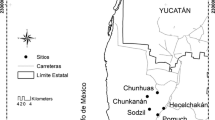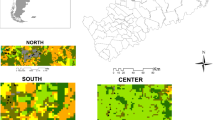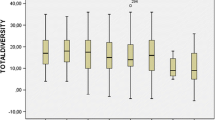Abstract
Context
Urban community gardens are globally prevalent urban agricultural areas and have the potential to fulfill human needs in impoverished neighborhoods, such as food security and access to open space. Despite these benefits, little research has been conducted evaluating environmental and socioeconomic factors influencing community garden plant biodiversity and ecosystem services (ES).
Objective
Our study investigated the drivers of managed plant richness, abundance, and ES production in community gardens across Los Angeles County, CA from 2010 to 2012 at regional, garden, and plot scales.
Methods
Fourteen community gardens were visited in the summers of 2010–2012 for comprehensive species surveys across regional, garden, and plot scales. We compared biodiversity to household income, plot size, and gardener ethnicity.
Results
In total, 707 managed plant species were recorded in summer surveys over a 3-year period. Ornamental plant richness increased with neighborhood income, while edible and medicinal richness increased with size of garden plots. Gardener ethnicity also influenced the composition of managed species, especially edible species.
Conclusions
We explain these patterns through a hierarchy of needs framework; gardeners preferentially plant species progressively less connected to human need. Ornamental plant increases in high-income regions may be explained by their requirement for financial investment and maintenance time. Cultural and provisioning ES are important for immigrant populations, resulting in ethnically distinct crop assemblages. Finally, distinct species–area relationships imply high demand for food abundance and biodiversity. Our quantitative results indicate that community gardens contribute to a biologically diverse urban ecosystem and provide valued ecosystem services in food insecure regions.









Similar content being viewed by others
References
Alaimo K, Packnett E, Miles RA, Kruger DJ (2008) Fruit and vegetable intake among urban community gardeners. J Nutr Educ Behav 40:94–101
Albuquerque UP, Andrade LHC, Caballero J (2005) Structure and floristics of homegardens in Northeastern Brazil. J Arid Environ 62:491–506
Anderson AJB (1971) Ordination methods in ecology. J Ecol 59:713–772
Anderson MJ, Crist TO, Chase JM, Vellend M, Inouye BD, Freestone AL, Sanders NJ, Cornell HV, Comita LS, Davies KF, Harrison SP, Kraft NJ, Stegen JC, Swenson NG (2011) Navigating the multiple meanings of beta diversity: a roadmap for the practicing ecologist. Ecol Lett 14:19–28
Austin MP (2005) Vegetation and environment: discontinuities and continuities. In: van der Maarel E (ed) Vegetation ecology. Blackwell Publishing, Ltd, Oxford, pp 52–84
Azuma AM, Gilliland S, Vallianatos M, Gottlieb R (2010) Food access, availability, and affordability in 3 Los Angeles communities, Project CAFE, 2004–2006. Prev Chronic Dis 7:1–9
Barthel S, Folke C, Colding J (2010) Social–ecological memory in urban gardens—retaining the capacity for management of ecosystem services. Glob Environ Change 20:255–265
Blanckaert I, Vancraeynest K, Swennen RL, Espinosa-Garcia FJ, Piñero D, Lira-Saade R (2007) Non-crop resources and the role of indigenous knowledge in semi-arid production of Mexico. Agric Ecosyst Environ 119:39–48
Boone CG, Cadenasso ML, Grove JM, Schwarz K, Buckley GL (2010) Landscape, vegetation characteristics, and group identity in an urban and suburban watershed: why the 60s matter. Urban Ecosyst 13:255–271
Chappell MJ, LaValle LA (2011) Food security and biodiversity: can we have both? An agroecological analysis. Agric Hum Values 28:3–26
Cilliers S, Cilliers J, Lubbe R, Siebert S (2012) Ecosystem services of urban green spaces in African countries—perspectives and challenges. Urban Ecosyst 16:681–702
Clarke LW, Jenerette GD, Davila A (2013) The luxury of vegetation and the legacy of tree biodiversity in Los Angeles, CA. Landsc Urban Plan 116:48–59
Clarke LW, Jenerette GD, Bain DJ (2014a) Urban legacies and soil management affect the concentration and speciation of trace metals in Los Angeles community garden soils. Environ Pollut. doi:10.1016/j.envpol.2014.11.015
Clarke LW, Li L, Jenerette GD, Yu Z (2014b) Drivers of plant biodiversity and ecosystem service production in home gardens across the Beijing Municipality of China. Urban Ecosyst 17:741–760
Cocks M (2006) Biocultural diversity: moving beyond the realm of ‘indigenous’ and ‘local’ people. Hum Ecol 34:185–200
Colding J, Lundberg J, Folke C (2006) Incorporating green area user groups in urban ecosystem management. Ambio 35:237–244
Corlett JL, Dean EA, Grivetti LE (2003) Hmong gardens: botanical diversity in an urban setting. Econ Bot 57:365–379
Corrigan MP (2011) Growing what you eat: developing community gardens in Baltimore, Maryland. Appl Geogr 31:1232–1241
Davis JN, Ventura EE, Cook LT, Gyllenhammer LE, Gatto NM (2011) LA Sprouts: a gardening, nutrition, and cooking intervention for Latino youth improves diet and reduces obesity. J Am Diet Assoc 111:1224–1230
Draper C, Freedman D (2010) Review and analysis of the benefits, purposes, and motivations associated with community gardening in the United States. J Commun Pract 18:458–492
Fedick SL (ed) (1996) The managed mosaic: ancient Maya agriculture and resource use. University of Utah Press, Salt Lake City
Fraser EDG, Kenney WA (2000) Cultural background and landscape history as factors affecting perceptions of the urban forest. J Arboric 26:106–113
Fu Y, Guo H, Chen A, Cui J (2006) Household differentiation and on-farm conservation of biodiversity by indigenous households in Xishuangbanna, China. Biodivers Conserv 15:2687–2703
Galluzzi G (2012) Agrobiodiversity and protected areas: another approach to synergies between conservation and use? On-farm conservation of neglected and underutilized species: status, trends and novel approaches to cope with climate change—Proceedings of the international conference, Friedrichsdorf, Frankfurt, pp 14–16
Galluzzi G, Eyzaguirre P, Negri V (2010) Home gardens: neglected hotspots of agro- biodiversity and cultural diversity. Biodivers Conserv 19:3635–3654
Gaston KJ, Gaston S (2011) Urban gardens and biodiversity. In: Douglas I, Goode D, Houck MC, Wang R (eds) The Routledge handbook of urban ecology. Routledge, London, pp 450–458
Gottlieb R (2006) Reinventing Los Angeles; nature and community in the global city. The MIT Press, Cambridge
Grimm NB, Faeth SH, Golubiewski NE, Redman CL, Wu J, Bai X, Briggs JM (2008) Global change and the ecology of cities. Science 319:756–760
Guitart D, Pickering C, Byrne J (2012) Past results and future directions in urban community gardens research. Urban For Urban Green 11:364–373
Hale J, Knapp C, Bardwell L, Buchenau M, Marshall J, Sancar F, Litt JS (2011) Connecting food environments and health through the relational nature of aesthetics: gaining insight through the community gardening experience. Soc Sci Med 72:1853–1863
Hanna AK, Oh P (2000) Rethinking urban poverty: a look at community gardens. Bull Sci Technol Soc 20:207–216
Heraty JM (2010) Conservation of maize germplasm as a result of food tradition in southern California’s immigrant gardens. Master’s Thesis, UC Davis
Hooper DU, Chapin FS, Ewel JJ, Hector A, Inchausti P, Lavorel S, Lawton JH, Lodge DM, Loreau M, Naeem S, Schmid B, Setala H, Symstad AJ, Vandermeer J, Wardle DA (2005) Effects of biodiversity on ecosystem functioning: a consensus of current knowledge. Ecol Monogr 75:3–35
Hope D, Gries C, Zhu WX, Fagan WF, Redman CL, Grimm NB, Nelson AL, Martin C, Kinzig A (2003) Socioeconomics drive urban plant diversity. Proc Natl Acad Sci USA 100:8788–8792
Huai H, Xu W, Wen G, Bai W (2011) Comparison of the homegardens of eight cultural groups in Jinping County, Southwest China. Econ Bot 65:345–355
Hynes P (1996) Patch of Eden: America’s inner city gardens. Chelsea Green Publishing Company, White River Junction
Jackson J, Rytel K, Brookover I, Efron N, Hernandez G, Johnson E, Kim Y, Lai W, Navarro M, Pena A, Rehm Z, Yoo H, Zabel Z (2013) Cultivate L.A.; an assessment of urban agriculture in Los Angeles county. University of California Cooperative Extension, Los Angeles. http://www.cultivatelosangeles.org
Jansson A, Polasky S (2010) Quantifying biodiversity for building resilience for food security in urban landscapes: getting down to business. Ecol Soc 15(3):20
Jenerette GD, Harlan SL, Stefanov W, Martin C (2011) Ecosystem services and urban heat riskscape moderation: water, green spaces, and social inequality in Phoenix, USA. Ecol Appl 21:2637–2651
Kabir ME, Webb EL (2009) Household and homegarden characteristics in southwestern Bangladesh. Agrofor Syst 75:129–145
Kaplan R, Herbert EJ (1987) Cultural and sub-cultural comparisons in preferences for natural settings. Landsc Urban Plan 14:281–293
Kinzig AP, Warren P, Martin C, Hope D, Katti M (2005) The effects of human socioeconomic status and cultural characteristics on urban patterns of biodiversity. Ecol Soc 10:23–36
Koellner T, Schmitz OJ (2006) Biodiversity, ecosystem function, and investment risk. Bioscience 56:977–985
Larsen L, Harlan SL (2006) Desert dreamscapes: residential landscape preference and behavior. Landsc Urban Plan 78:85–100
Lawson L (2007) Cultural geographies in practice: the South Central Farm: dilemmas in practicing the public. Cult Geogr 14:611–616
Lawson L, Drake L (2013) Community Garden Organization Survey, 2011–2012. Commun Green Rev 18:20–41
Lawton JH (1999) Are there general laws in ecology? Oikos 84:177–192
Liu JG, Dietz T, Carpenter SR, Folke C, Alberti M, Redman CL, Schneider SH, Ostrom E, Pell AN, Lubchenco J, Taylor WW, Ouyang ZY, Deadman P, Kratz T, Provencher W (2007) Coupled human and natural systems. Ambio 36:639–649
Loram A, Warren PH, Gaston KJ (2008) Urban domestic gardens (XIV): the characteristics of gardens in five cities. Environ Manag 42:361–376
Lovell ST, Taylor JR (2013) Supplying urban ecosystem services through multifunctional green infrastructure in the United States. Landscape Ecol 28:1447–1463
Lowry, JH, Baker, ME, Ramsey, RD (2012). Determinants of urban tree canopy in residential neighborhoods: Household characteristics, urban form, and the geophysical landscape. Urban Ecosyst 15:247–266
Lubbe CS, Siebert SJ, Cilliers SS (2011) Socio-economic drivers of plant diversity patterns in domestic gardens of the Tlokwe City Municipality. S Afr J Bot 77:538–539
Mack RN, Erneberg M (2002) United States naturalized flora: largely the product of deliberate introductions. Ann Mo Bot Gard 89:176–189
Manes F, Incerti G, Salvatori E, Vitale M, Ricotta C, Costanza R (2012) Urban ecosystem services: tree diversity and stability of tropospheric ozone removal. Ecol Appl 22:349–360
Marco A, Dutoit T, Deschamps-Cottin M, Mauffrey JF, Vennetier M, Bertaudiere-Montes V (2008) Gardens in urbanizing rural areas reveal an unexpected floral diversity related to housing density. C R Biol 331:452–465
Marco A, Barthelemy C, Dutoit T, Bertaudière-Montes V (2010) Bridging human and natural sciences for a better understanding of urban floral patterns: the role of planting practices in Mediterranean gardens. Ecol Soc 15:2
Mathieu R, Freeman C, Aryal J (2007) Mapping private gardens in urban areas using object-oriented techniques and very high-resolution satellite imagery. Landsc Urban Plan 81:179–192
Matteson KC, Ascher JS, Langellotto GA (2008) Bee richness and abundance in New York city urban gardens. Ann Entomol Soc Am 101:140–150
Méndez VE, Lok R, Somarriba E (2001) Interdisciplinary analysis of homegardens in Nicaragua: micro-zonation, plant use and socio-economic importance. Agrofor Syst 51(51):85–96
Millennium Ecosystem Assessment (2005) Ecosystems and human well-being: synthesis. Island Press, Washington, DC, pp 0–155
Minkoff-Zern LA (2012) Pushing the boundaries of indigeneity and agricultural knowledge: Oaxacan immigrant gardening in California. Agric Hum Values 29:381–392
Pataki DE, McCarthy HR, Gillespie T, Jenerette GD, Pincetl S (2013) A trait-based ecology of the Los Angeles urban forest. Ecosphere 4(6):72. doi:10.1890/ES13-00017.1
Peña D (2005) Farmers feeding families: agroecology in South Central Los Angeles. Lecture presented to the Environmental Science, Policy and Management Colloquium
Peña D (2006) Toward a critical political ecology of Latina/o urbanism. The Acequia Institute. http://www.acequiainstitute.org/researchreports.html
Pickett ST, Cadenasso ML, Grove JM, Boone CG, Groffman PM, Irwin E, Kaushal SS, Marshall V, McGrath BP, Nilon CH, Pouyat RV, Szlavecz K, Troy A, Warren P (2011) Urban ecological systems: scientific foundations and a decade of progress. J Environ Manag 92:331–362
Schwarz K, Pickett ST, Lathrop RG, Weathers KC, Pouyat RV, Cadenasso ML (2012) The effects of the urban built environment on the spatial distribution of lead in residential soils. Environ Pollut 163:32–39
Shaffer A (2002) The persistence of L.A.’s grocery gap: the need for a new food policy and approach to market development. Center for Food and Justice Report. UEPI, Los Angeles
Sharkey JR, Horel S, Han D, Huber JC (2009) Association between neighborhood need and spatial access to food stores and fast food restaurants in neighborhoods of Colonias. Int J Health Geogr 8:9
Smith RM, Gaston KJ, Warren PH, Thompson K (2005) Urban domestic gardens (V): relationships between landcover composition, housing and landscape. Landscape Ecol 20:235–253
Smith RM, Thompson K, Hodgson JG, Warren PH, Gaston KJ (2006) Urban domestic gardens (IX): composition and richness of the vascular plant flora, and implications for native biodiversity. Biol Conserv 129:312–322
Smith VM, Greene RB, Silbernagel J (2013) The social and spatial dynamics of community food production: a landscape approach to policy and program development. Landscape Ecol 28:1415–1426
Soleri D, Cleveland DA (2004) Farmer selection and conservation of crop varieties. In: Goodman RM (ed) Encyclopedia of plant and crop science. Marcel Dekker, New York, pp 433–438
Splash CL (2008) How much is that ecosystem in the Window? The one with the bio-diverse trail. Environ Values 17:259–284
Stark BL, Ossa A (2007) Ancient settlement, urban gardening, and environment in the Gulf Lowlands of Mexico. Lat Am Antiq 18:385–406
Taylor JR, Lovell ST (2014) Urban home gardens in the Global North: a mixed methods study of ethnic and migrant home gardens in Chicago, IL. Renew Agric Food Syst. doi:10.1017/S1742170514000180
United Nations Department of Economic and Social Affairs Population Division (2014) World Urbanization Prospects: The 2014 Revision, Highlights. United Nations, New York
United States Census Bureau (2010). American FactFinder Profile of General Population and Housing Characteristics for Los Angeles County. http://factfinder.census.gov/faces/nav/jsf/pages/community_facts.xhtml
USDA (2014) Food Access Research Atlas. http://www.ers.usda.gov/data-products/food-access-research-atlas.aspx
van Heezik Y, Freeman C, Porter S, Dickinson KJM (2013) Garden size, householder knowledge, and socio-economic status influence plant and bird diversity at the scale of individual gardens. Ecosystems 16:1442–1454
Vavilov NI (1949) The origin, variation, immunity, and breeding of cultivated plants. Chron Bot 13:1–364
Wakefield S, Yeudall F, Taron C, Reynolds J, Skinner A (2007) Growing urban health: community gardening in South-East Toronto. Health Promot Int 22:92–101
Walker JS, Grimm NB, Briggs JM, Gries C, Dugan L (2009) Effects of urbanization on plant species diversity in central Arizona. Front Ecol Environ 7:465–470
Wang H-F, MacGregor-Fors I, López-Pujol J (2012) Warm-temperate, immense, and sprawling: plant diversity drivers in urban Beijing, China. Plant Ecol 213:967–992
Wu J (2013) Landscape sustainability science: ecosystem services and human well-being in changing landscapes. Landscape Ecol 28:999–1023
Acknowledgments
For field research and data support, we thank Liangtao Li, Cara Fertitta, Lauren Velasco, and members of the Jenerette lab at UC Riverside. We also thank Derick Fay, Edith Allen, Norm Ellstrand, and Exequiel Ezcurra for ongoing research discussion. Finally, we thank UC Riverside herbarium director, Andrew Sanders for extensive aid in species identification and archiving samples. This project was supported by the US National Science Foundation (DEB 0919006), and the University of California, Riverside.
Author information
Authors and Affiliations
Corresponding author
Electronic supplementary material
Below is the link to the electronic supplementary material.
Rights and permissions
About this article
Cite this article
Clarke, L.W., Jenerette, G.D. Biodiversity and direct ecosystem service regulation in the community gardens of Los Angeles, CA. Landscape Ecol 30, 637–653 (2015). https://doi.org/10.1007/s10980-014-0143-7
Received:
Accepted:
Published:
Issue Date:
DOI: https://doi.org/10.1007/s10980-014-0143-7




